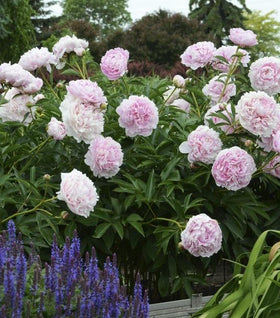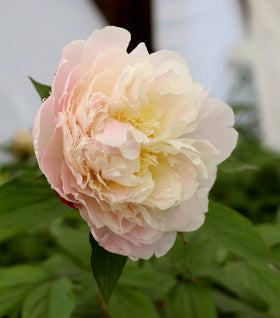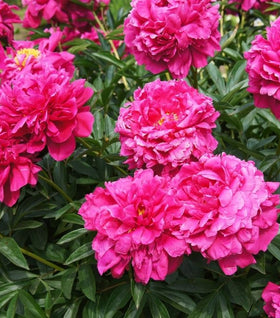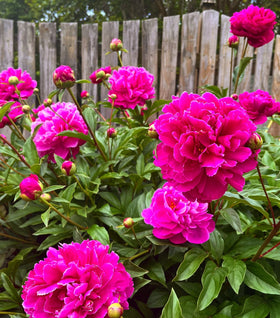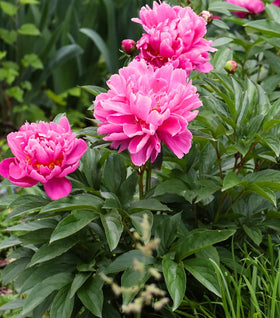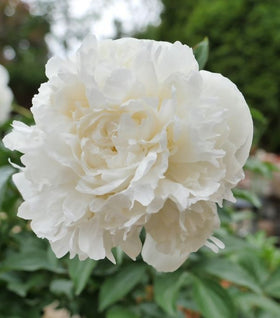Peony Plants for Sale Online
Peony plants have been a popular perennial flower in American gardens since the 1800s. No home was complete without a fresh bouquet of peonies. The sweet scent and large, double flowers were a mainstay in affluent homes thanks to nurseryman Amasa Kennicott from Chicago.
Kennicott was the first flower grower to discover how to store fresh cut peony flowers. His techniques allowed peonies to be shipped to florists around the country and changed homes' look with these gorgeous cut flowers.
These gorgeous flowering perennials are renowned for their spectacular blooms, beautiful foliage, and rich fragrance. Peonies come in a rainbow of colors. Today peonies are available in various rich reds, pure whites, and pastel shades, including pinks.
Today's peonies offer many big, beautiful flowers that bloom above the luxuriant deep green foliage. Try peonies today and we're confident you'll want to add more peonies to the spectacular summer show in your garden.
Peonies are easy to care for in the garden requiring very little input from gardeners to remain healthy. They rarely need fertilizer and are highly resistant to deer. When planted in full sun to partial shade in well-drained soil, they can grow up to 3 feet tall and produce magnificent 5- to 7-inch flowers.
These stunning beauties are very hardy and don't mind chilly winters. Peonies thrive in zones 3 through 8, which covers a large portion of the country, stretching as far north as northern Minnesota. They occasionally will require staking as the big, heavy flowers can weigh down their stems after a rainstorm. Peonies' are very hardy, and some plants have been known to live for 100 years, making them a true heirloom perennial.
The attractive leaves of peonies stay green long after the peonies' flowers have faded, so they are perfect for planting in mixed borders. They are also suited for planting along walkways and sidewalks where visitors and guests may enjoy their fragrance and beauty. Mixing the pastel pink peonies with fully double white blooms creates a soft yet colorful display. Peonies are outstanding and long-lasting cut flowers and are often seen in bouquets.
How to Plant Peonies
Buying potted peony plants is the preferred way to plant peonies for most gardeners. Most peonies bought today have been grown in the pot at least for a full season, meaning they are typically 2-year-old plants. This is important as bare-root peonies typically won't bloom for at least two years. Buying potted peonies allows gardeners to skip the "non-blooming" years and enjoy the large flowers sooner.
Sun Requirements for Peonies
Peonies prefer a location that receives a minimum of 6 hours of bright sun per day. More is better as far as peonies are concerned. If peonies are planted in areas with less sun, you will get fewer blooms, and the flowers may actually be smaller.
Sunlight also has the added benefit of making the foliage and flowers dry faster. Peonies that do not dry quickly after wet periods can get leaf fungus' like powdery mildew, which is favored by wet conditions. Sunlight is the best and easiest control for this disease.
Soil requirements of Peony Plants
Peonies are adaptable to many different soil types; however, they prefer well-drained soil with a slightly acidic profile. If your area has heavy clay soil, it is recommended that you amend the soil with locally sourced compost. If your garden grows azaleas and rhododendrons well, peonies will do very well in your garden. Since peonies are long-lived, taking the time to prepare the soil properly will pay dividends over the years in flowers and fragrance.
Watering Peonies
Peonies prefer evenly-moist well-drained soil, and given this, they will thrive for many years. When watering peony plants, it's recommended that you water the plant's base and not the foliage. This helps to prevent diseases and gets the maximum amount of water to the root-zone. Peonies are not drought resistant and benefit from occasional watering during extended periods of dry weather.
Fertilizing Peonies
Peonies are not heavy feeders and get the maximum benefit from just a light feeding in the spring with a balanced fertilizer such as Espoma Flower-Tone. Espoma Flower-tone is organic and blended specifically to enhance plant growth, but more importantly, it boosts flower production rather than heavy foliage. Just sprinkle it at the base of the plant and water it in.
Mulching Peonies
Peonies should be mulched yearly to help them retain water and lessen the likelihood of weeds. Don't over mulch peonies; that is to say, a 2-inch layer of mulch is more than adequate after initial planting. In the following years, a 1-inch layer is more than sufficient.
Some peony growers will remove the previous year's mulch before applying a new layer each spring. Thin layers are better for peonies as they benefit more from the natural warming of the soil from the sun in the spring rather than the insulation of thick layers of mulch in the winter.
Pruning Peonies
Peonies are herbaceous perennials. This means that they die back to the ground at the end of fall and resprout in the spring. Cutting back the browning foliage in the late winter will make your garden look tidy. Still, more importantly, it helps to prevent insects and diseases from overwintering around your prized peony.
When pruning peonies in the fall, remember not to disturb the plant's crown as this can affect the following year's growth and flowers.
Dead-heading peonies are the process of removing the spent and faded blossoms after a flower stem is done blooming. This will give your peonies a clean look and will not distract from the fresh blooms that will appear on the plant.
Growers of florist peonies mostly employ another pruning technique specific to peonies, and this is to remove a percentage of the flower buds before blooming. This technique can help the peony to produce larger flowers. Understand that this technique will reduce the overall amount of flowers, but the remaining flowers will be larger and more vibrant.
The care of peonies is pretty straight forward, and this group of perennials is one of the easiest to care for if you take the time to select the right location and prepare the soil to support the plant's needs.

